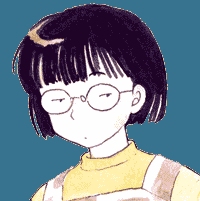

Reading MAO with Agatha Christie’s Rules & Criticisms of Shogakukan’s Marketing Strategies
By Olivia Chan Yuen Yue
Rumiko Takahashi once mentioned [1] she is a big fan of Agatha Christie and she constructed MAO referring to Agatha’s ways of writing. [2] I have read around ten of Agatha Christie’s works (of course I’m just a beginner compared to Rumiko!) and basically Agatha followed most of the “Rules of Detective Fiction” that were established during in the "Golden Age" of the literary genre and codified by Ronald Knox and S.S. Van Dine.
With supernatural elements, MAO looks like a time-travel adventure story but most detective fiction rules can still apply. I am going to introduce some of the rules and how Rumiko is playing with those. I hope it can help you to understand and read MAO in a more enjoyable way!
There are spoilers for MAO for necessary reasons but I don’t spoil any of Agatha Christie's story in the following article.
1. There must be a "detective" in detective fiction - so who is the detective?
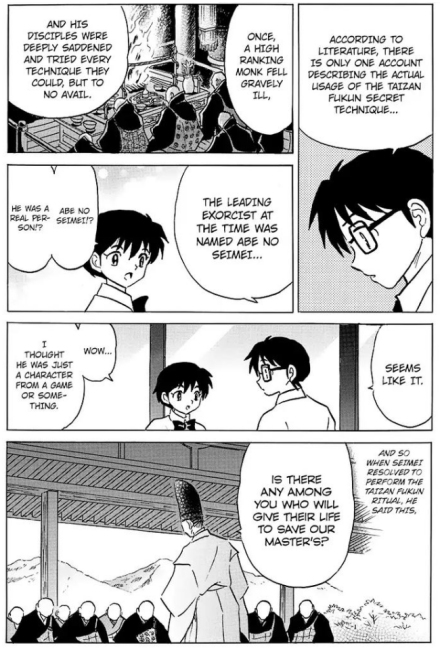
According to S.S. Van Dine’s 20 rules, detective fiction must have a detective in it - it’s not about his/her occupation, it’s the role and their function. And the detective himself/herself must not be the murderer. [3] Van Dine's rule states that the reader must have an equal opportunity with the detective to solve the mystery. It’s a “fair play” between the detective and the reader.
Does everyone think that "detective" is Mao? No, he is the male lead and Nanoka’s love interest but he is only one of the sources of information. Typical gender stereotype!
So theoretically he’s still one of the suspects - The true detective is Nanoka. So I tend to believe it is a must to combine clues in modern times to get the whole picture.
Nanoka is the only one who views things from the reader's point of view and gathers the important clues. For example, information provided by Shiraha and the cat demon, Byoki. The interesting point is that Nanoka doesn't always share the information with Mao, like in chapter 35 (was she distracted or just forgot?). It's easy for everyone to ignore Shiraha’s words and see him as an unimportant character.
On the other hand, even though we believe Mao isn’t malicious, he actually hid a lot of clues, such as seeing Sana and Daigo on a date and seeing the blue ball of light. He would only reveal it when the time came to do so.
Indeed, Agatha Christie had played similar the identity tricks to confuse the readers, e.g., the helpful assistant of the detective, the doctor, the love interest or “I” as the true criminal. However... considering it’s a manga published by Shogakukan, it would be too dark if Mao was the true villain.
Still, we shouldn’t take Mao’s opinions as the 100% truth. For example, his understanding about certain characters and his incomplete knowledge of the Goko Clan. This kind of information may be misleading for readers or be an intentional way sidetrack us.
2. Who are the “corpses” and what are the mysteries?
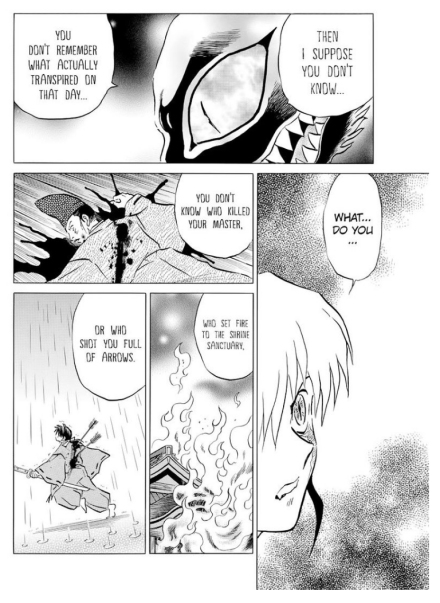
The mysteries are the centre of any detective fiction and the rules of S.S. Van Dine even state there must be at least a corpse. So who are the corpses in MAO and what are the unsolved mysteries?
The cat demon raised four major mysteries in chapter 19 during his confrontation with Mao:
- We are both being cheated. (By who?)
- You don’t know who killed your master.
- Who shot you full of arrows?
- Who set fire to the shrine sanctuary?
- Did he (Mao) kill Sana? If not, who killed her?
- Mokuzu is the one who turned Haimaru into the cat demon, but who orchestrated this plan and why?
- Daigo was not killed by mistake but why did his body disappear? Why was he killed for real instead of simply faking his death as he planned?
- Who makes Natsuno live and why?
- Why is Yurako staying with Hakubi and Shiranui? What is their relationship?
There are tons of mysteries and the corpses that Van Dine says are critical to any mystery are Sana, Mao’s master and maybe Daigo as seen in chapter 143. So far only one of their murderers has been revealed.
And there also are some more fundamental mysteries that not literally raised by any characters, which I don’t know whether these will be revealed:
- Why can Nanoka time travel? Did anyone create the gate she uses? If so, why?
- What the Goko Clan actually is and who is the master?
- Why is there no record or history about the Goko Clan in modern times?
3. There are no binary “good” or “bad” characters - they are all not completely trustable
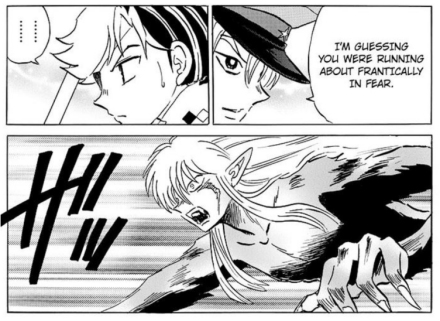
Sidetracks, stereotypes and sympathy are the three usual strategies used by Agatha Christie to surprise the readers while at the same time following fair play with readers. [4] Ronald Knox’s rules state, "the criminal must be mentioned in the early part of the story but must not be anyone whose thoughts the reader has been allowed to know." [5]
In common shonen manga, there are always “good people” on the protagonists' team and “bad people” in the antagonists’ team. [6] However, in detective fiction like MAO, everyone is suspicious, including the cutest or the kindest one. And all the clues are probably already plotted in the early part of the story.
Although Hyakka looks so innocent and upright, it turns out he was the one who burned the Goko Clan's sanctuary at Sana's request. The clues were already plotted when he first appeared - his fire tricks burned the things in the Clan. And when Hakubi scoffed at him for being a coward and running away that night, Hyakka gave no response. It was quite out of character for him! These kinds of clues are something readers should bear in mind.
Even the cutest boy Hyakka is not trustworthy, as a result we should even pay more attention to Kamon and Natsuno who also seem like "good people".
Kamon said that he went out on a tryst the night of the Goko Clan's demise but there was no witness. Natsuno gave the earth bell to Nanoka to “absorb the power from the earth” but is that the bell's only purpose? The earth bell seems to trigger something in modern time as well and it becomes a turning point in the story.

4. Conclusion & criticisms of Shogakukan’s marketing strategies
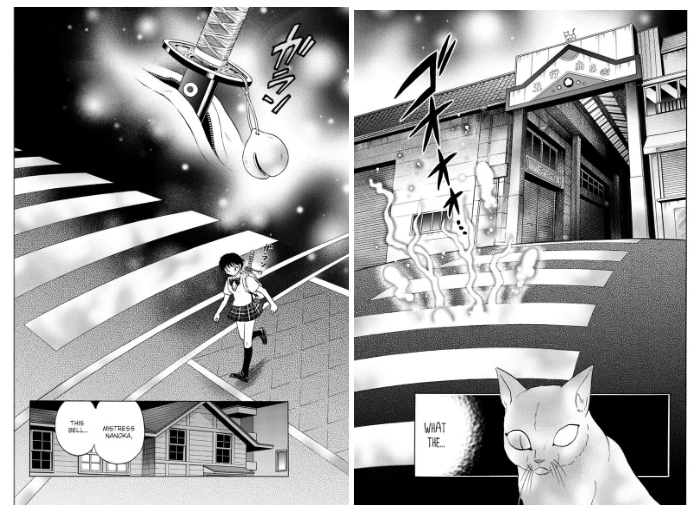
Detective fiction is different from adventure fiction - it’s a mind game between the author and the readers, instead of simply surprising the readers with twists. The development of the story and the truth must be reasonable and there must be enough clues to allow readers to play the “fair game”. It should be a fun journey with lots of discussion!
As the clues are usually hidden in dialogues, the fights are not that important (though some fights are meant to reveal some truths, like Shiranui‘ legs). So there is no super powerful character like Sesshomaru nor an absolutely evil character like Naraku. The power dynamics are relatively balanced and characters’ intentions are more humanistic. Although MAO looks like a time travel adventure on its cover, Rumiko Takahashi followed the rules of detective fiction even stricter than Gosho Aoyama.
So I think it is the wrong marketing strategy to always bundle MAO with the Inuyasha and Yashahime series. It is the easiest but also the laziest approach! The publisher did not even remind readers it is a detective manga so readers seldom actively spot and analyse the clues.
Inuyasha is a time travel adventure with heavy elements of romance. It is inevitable that some people reading MAO with such expectations will be disappointed. They just wait for being spoon-fed the super cool characters, love triangles and fight scenes!
I do not blame the readers, it is a marketing mistake of Shogakukan!
Footnotes
- [1] Takahashi, Rumiko. Twitter Post. June 4, 2021, 4:00 AM. https://twitter.com/rumicworld1010/status/ 1400754206647128064.
- [2] Kadokura, Shima. "Rumiko Takahashi: Beyond Boundaries" DaVinci Vol. 12, 2020. https://www.furinkan.com/ takahashi/takahashi51.html.
- [3] Van Dine, S.S. "Twenty Rules for Writing Detective Fiction." The American Magazine September 1928, 26-30.
- [4] Corrigan, Maya. "Agatha Christie: Clues and Surprise Endings." MayaCorrigan.com. October 10, 2022. https://www.mayacorrigan.com/christies-clues.html.
- [5] Knox, Ronald A. "Detective Story Decalogue" Best Detective Stories of 1928-1929, 1929.
- [6] In Japanese detective fiction the Honkaku Mystery Writers Club of Japan are often considered to focus on the procedural aspects of mystery writing. They draw a connection to the processes laid out by Knox, Christie and Van Dine during the "Golden Age of Detective Fiction". "Honkaku" (本格) means "orthodox" and the group describes how mature Japanese detective fiction took shape in the post-war years with writers such as Tetsuya Ayukawa, Seishi Yokomizo and Akimitsu Takagi.
Olivia Chan Yuen Yue lives in Hong Kong and is a fan of both Rumiko Takahashi and Agatha Christie. You can read more of Olivia's thoughts on MAO in her article about Grandpa Kiba. You can read more MAO hypotheses in Harley Acres' article.
